28 Effective Ways to Improve Domain Authority
Domain Authority ranks as one of the most important to increase organic website traffic. Learn these secrets of improving your domain authority today!

Having a successful website can be determined by a range of factors, and organic traffic definitely ranks as one of the most important factors. To increase organic traffic to your website, you need to understand what is domain authority (DA) and how to improve this metric.
Big disclaimer: DA isn’t directly responsible for driving traffic to a site but still has a major role worth noting.
To understand this issue completely, we need to delve into the workings of domain authority. Let us begin with its definition.
What is Domain Authority?

Domain Authority refers to the strength of an entire web domain (how authoritative the website in question is, compared to other sites) and it is also a predictor of how well a website will rank on search engine result pages (SERPs). It is measured on a scale of 1 to 100 — with 1 being the worst and 100 being the best, and was a metric designed by MOZ. Being a logarithmic function, it gets progressively harder to improve domain authority scores as it climbs the ranks.
Domain authority is split into several sub-factors such as link diversity, link quality, domain age, number and quality of backlinks, social media mentions and brand search volume. The exact percentages can be found on this graph by SEO Siren (see below). In fact, you will need to target these factors to improve the overall domain authority of a site.
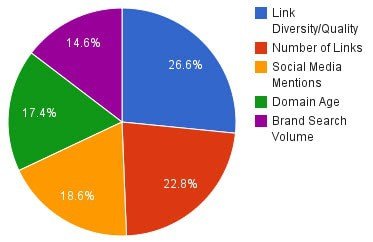
How Much Domain Authority is Good?
In numerical terms, a score of 75 to 100 is complete domination amongst websites providing similar information, anything above 60 is considered excellent, and the usual average for most websites are anything between 30 and 50. New websites or subpar websites can expect themselves to linger about the sub-30 range.

However, don’t be obsessed over the absolute values, use the tool as a comparative metric to see how you fare against rivals in the same niche. (For more details on this subject, check out this article by the creators of the metric itself.)
In practical terms, this means that larger, more established websites have the best domain authority and will be likeliest to feature on google’s pages when searches are made for related keywords or content.
Thus, if you want your website to stand a fighting chance in today’s highly saturated world of websites, and dominate your niche, it is extremely essential to increase domain authority of your business’s e-address. Having a great domain authority not only makes your content more competitive, it also acts as a signifier of reliability and trust.
How to Check your Domain Authority?
There are a few solutions out there in the market, which can help you check how much is your domain authority? Just key in your domain URL, and they will return you the results.
Here is a free domain authority checking tool from Ahrefs that you can consider to use.
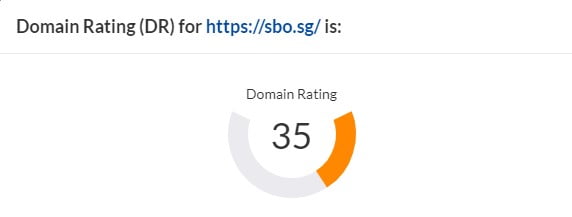
Understanding the Importance of Domain Name

1. Select A Relevant Domain Name
For those who already have a domain, it may be tough to change this, but beginners should take heed of this important trick.
Select a domain name that is relevant and objectively good.
For example, the domain name “drawmanga.com” is good for a website specialising in Japanese manga art as the domain name contains relevant keywords in its name.
In all cases, keep the name simple and easy to remember. Viewers and customers have short attention span and limited memories, so do not pepper them with too much complexity.
2. Purchasing Expired Domains
If those types of domains are taken but unused, simply buy the domain and claim the benefits of a relevant name and domain age (which is covered later in this article) at the same time.
This is a quick way to move on to the next steps in the optimization process.
3. Selecting a ‘clean’ domain
If you have decided on buying a used or expired domain based on the aforementioned considerations, it is still advisable to run a thorough background check on it before migrating over.
Many old websites and domains may contain spam and other toxic material which can cause the website to be negatively rated on google’s search algorithm (or even Moz’s domain authority ranking).
In the case that a cleanup simply can’t save the site, it’s time to move to another domain – in which case, go back to the first step.
How to Increase Domain Authority Through Good Content Strategy

Improving domain authority is a long term project that starts from the foundation-up, which means that the target domain is required to have enough content which is valuable and useful to its target audience. Here are some fundamental ways to structure and adapt content to increase domain authority.
1. Create High Quality Content
There can be no skipping of this step: it is crucial for a website to have solid, educational and useful content for it to be scoring on the DA charts. Be it a blog, e-commerce feature, forum or whatever, make sure that decent, quality content is being produced. Only then will your website attract viewer traffic.
Amazing content naturally attracts attention, as it has intrinsic value, which is a great way of promoting organic link building.
In addition, it gives your website a better reputation. The process of good content creation also means throwing in pictures and diagrams to help improve readability and user experience.
This ties in to our next point…
2. Increasing Viewer Dwell Time

The amount of time spent on a website is a relatively accurate marker for domain authority, as it closely correlates to the quality and quantity of content on a website. Better content generally hooks viewers in, and if there are a multitude of internal links and recommendations which allow the user to linger on the domain, this is a likely sign that the information hosted on the site is useful and valuable, as the user has committed more of their time to it.
This is very true for blogs or newsletter-like sites which can incorporate various internal links and long-form articles to maximize dwell time, and draw readers into a spiral of related articles (this effect can be seen with Wikipedia marathons, which are a clever use of internal links).
3. Increase Content Quantity
Producing content at a prolific rate can be a surefire way to increase viewer dwell time due to the sheer volume that is contained within the site. This can be done through the use of long-form articles (a trick that works well for blogs and forums), or simply producing so many different articles about various subjects in a given niche.
For instance, a blog about SEO can write about Backlinks, Content Creation, Website Optimisation and spread the articles across the domain, providing readers links from one article to another.
Articles with 2000 or more words tend to contain more internal links, have better descriptive content, have a higher chance of attracting backlinks (as mentioned, amazing content attracts attention) and tend to be more in-depth than their shorter counterparts.
Disclaimer: Do not exceed 7000 words or it could turn your page into an encyclopedia (or religious text) that no one will have the patience to finish reading.
The power of creating massively informative articles can be outlined by Backlinko’s Skyscraper Content Framework and is highly useful in improving domain authority.
However, do not skimp on quality when trying to maximize quantity – if the content is long and useless it will be treated as spam. Keyword stuffing is frowned upon and for good reason – it doesn’t add value to the lives of readers.
4. Making Evergreen Content
There are some ideas, concepts and themes that stick around for the long run, and stay relevant until the next paradigm shift. Such write-ups come under the umbrella term of Evergreen content. Having one or two samples of evergreen content on your website is extremely valuable as evergreen content attracts clicks, backlinks and the usual – but for a really long time.
This means that a single page can be the main source for outsiders to view the website, and it can ‘tank’ on-coming viewership traffic for months, possibly even years, adding to the domain age and reputability of the domain.
Great evergreen content can be a life-saver for domains in industries that are rapidly-shifting and have fast-paced changes. While several principles may become different over time, the important, juicy bits that stand the test of time are valuable.
Hence, making the best evergreen content in a niche can allow you to stand out and reap the rewards.
5. Publish Infographics and Non-text Format Content

Diversification of your content is another savvy method to increase viewership and improve user-friendliness of your domain. Infographics are a handy visual aid for readers who are tired of plowing through layers of text, and can engage an audience’s attention for longer periods of time.
Infographics also tend to be re-posted everywhere – Pinterest, Tumblr, Facebook, Instagram, Imgur – social media, forums and image hosting sites are a hotbed of infographic activity.
Based on Hubspot’s Visual marketing stats, infographics are three times more likely to be shared on social media than any other type of content.
While this may have led to the influx of inaccuracies and misinformation in today’s media, it can be used to an SEO engineer’s advantage to gain more external links. Just make sure the content is of an objectively high standard and you should be good to go.
6. Post Content Frequently
While it is of paramount importance to make quality content, ensure that the amount of time spent between periods of production and release are not too long, as a sub-feature of domain authority is the frequency that content is published on the domain.
Try to maintain a steady flow of content as this indicates that your website is relevant to changes within the niche/industry.
Additionally, the main reason for this tactic is to keep engagement levels on your site high. A higher level of engagement in the comments section or blog increases the social credibility of your website.
However, do not create fluff content that not only distract reader, but fails to add value to your domain. Ensuring a solid level of quality control will allow your content frequency to be meaningful.
7. Keep Your Content Updated
One of the biggest mistakes that will cause you to fall behind the competition is the irregularity of reviewing and updating old posts and content that may have become outdated.
Again, this is another way of maintaining engagement levels and frequency.
8. Dominate Your Niche

This point ties in with high quality content and evergreen content. By becoming the leading authority on a subject (in the real world and online), the winner-takes-all effect will cause your domain authority to skyrocket.
It helps if you are competing in a highly specialised field or a niche service (audiophiles, custom yo-yo designs, taxonomy etc.) to create top notch content that will cover most of the topics within that field, which means competitors will find it hard to top the stuff you have already contributed.
Another way to top the lists in your niche is to improve Local SEO such that your business improves in real life. The added engagement and traffic to your site will be a surefire indicator to the crawlers and indexers that your business is a leader in its domain (pun intended).
9. Social Media Outreach

In this day and age, most everyone has an Instagram, Facebook, Twitter or Reddit account. Social media outreach has never been as widespread as it is now.
Harness this power by actively interacting and pumping out content through these various channels, which can reach millions in a day. As mentioned earlier, infographics are the largest percentage of content on Facebook, Pinterest and Instagram, due to the easy digestible nature of the medium. Use the repost option to spread your ideas far and wide.
Additionally, using social media to connect with peers and other professionals in the industry can help boost your domain presence, especially if your content is of the highest calibre.
Link Strategy for Domain Authority Growth

The concept of backlinking is essential to building strong domain authority. Ensuring good backlinking practices can allow your domain authority to go a long way, and improve your website in various ways.
1. Remove Toxic Backlinks and Spam
As mentioned, your website should be free of nonsense that doesn’t add value to people’s lives. This obviously includes spam links and fluff thrown in just to game search engine algorithms.
In fact, stuffing keywords and spamming of irrelevant backlinks has an opposite effect and in most cases is a huge turn-off for consumers. This can also lead to penalties and decrease in domain authority.
Another major no-no of backlinking is having your content lead linked to broken sites, or backlinks obtained from paid backlink websites or shady loan sites. It should be maintained that engaging in Black Hat SEO tactics are in general, only detrimental to domain authority.
Clean up your toxic links by disavowing bad links, and conduct reviews every month or so.
For a basic breakdown on backlinks, learn more on the article about the dilemmas of backlinking.
2. Increase Authoritative Links
Now that you’ve focused on cleaning up the bad backlinks on your site, it’s important to start filling that vacuum with beneficial backlinks.
If your website contains more useful backlinks from authoritative sources (making sure that they are dofollow links), your domain authority will start to rise. Think of it as standing on the shoulders of giants. Reaching out via email to websites with a larger reputation and domain authority can deliver crucial affiliate links that can boost your domain authority the right way.
To ensure that you have a healthy amount of quality backlinks, do a website audit regularly to review links (refer to the point above).
3. Improving Internal Links
Having a properly designed network of internal links on your domain is another key step to maximizing domain authority. This point works in tandem with a strong base of quality content and frequent publishing of posts.
There are 3 main reasons to improve your internal link network:
Intuitive and straightforward navigation of the site
Clear and focused content hierarchy and flow
Increased propagation of link juice
Utilising internal links not only increases dwell time by virtue of making the user stay on your web domain for a longer period of time, but it also improves the user experience, which leads to a higher rate of a new user returning to the site.
Furthermore, the more internal links you have, the easier it is for search engines to index the domain.
4. Smart External Links
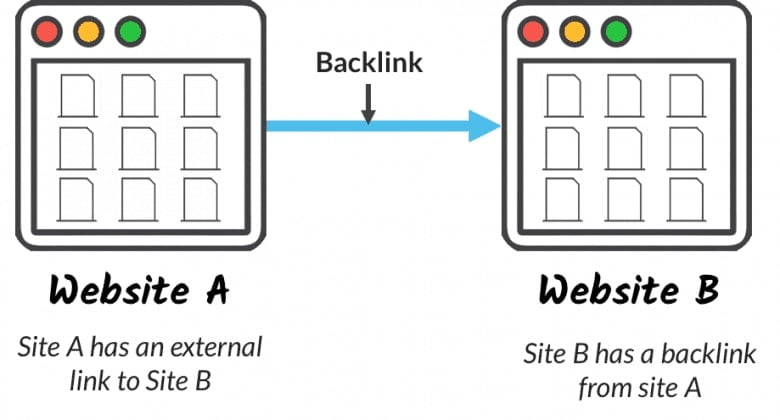
Being extremely shrewd with how you use external links is another way to tweak the odds in your site’s favour.
Linking to other websites is a good thing, especially if you are trying to illustrate certain points, but giving away too many links to other sites without obtaining backlinks that link to your site is a huge opportunity missed.
Use the ‘nofollow’ link option when giving out backlinks to certain formats of content such as tools, plugins and commercial links.
Additionally, you can program links to open on new tabs to prolong the dwell time a user spends on your site (especially if they are simply using the link as reference material).
5. The Guest Blogging Tactic
To widen your audience and gain organic backlinks, the guest blogging tactic is a solid option. Not only does it increase engagement levels, it can open up your website to new possibilities as a different set of viewers becomes aware of your site’s existence.
To execute this strategy effectively, follow these tips:
- Select websites with high domain authority to post on
- Write compelling, valuable content
- Connect with the blog owner via social media, email or blog comments
- Use guest posts to lead traffic to your landing pages
Overall, this will grow your audience and increase social presence in the relevant niche you are trying to rank in.
6. Commenting on Blog

A trick that is related to the previous one is >commenting on others’ blogs and articles to generate attention to your site.
This is an age-old method but it still works, plus it shows that you are engaging with external content and other creators on the internet. Remember to offer genuine insights and value while commenting, as that will also boost your own reputation.
7. ‘Related Articles’
Another top tactic to increase viewer retention is to add related articles or recommended reading links at the bottom of every article, which directs users down a fixed path of reading materials and increase dwell time.
This also ties in to the strong network of internal links and the art of directing users towards landing pages.
Prowess in Technicalities of Website
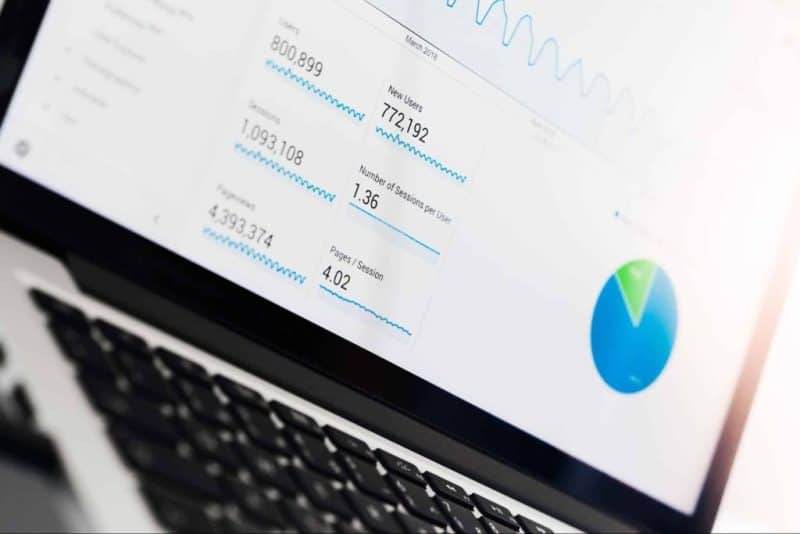
In addition to solid content and link building strategies, the technical aspect of your domain needs to be just as robust as the other two components. If the overall structure and technical side of your website is lacking, incoming traffic may not be optimised.
1. Improve Page Loading Speed
One of the biggest frustrations for a consumer or user is slow web pages that take ages to load. Web pages that load smoothly increases audience retention, leading to increased dwell time, which in turn improves domain authority.
Instant access to the website means increased viewer retention. Don’t make your users wait for the pages to load; optimise processes on the pages to streamline them and reduce wait times.
How can you do this? Here are some easy ways to speed up your site:
- Remove redundant plugins that clutter the site
- Optimize image file size
- Install a caching plugin (this saves an HTML page instead of PHP)
- Upgrade to a more powerful server
2. Having a User-Friendly Site

This may seem trivial, but having a well designed user interface (UI) is key to boosting domain authority. This ties in with the previous advice on increasing viewer dwell time and adding value to your users lives.
Apart from aesthetic value, a well designed interface can also allow users to navigate around your website easily and intuitively. Nobody likes using interfaces that are clunky, outdated and frustrating.
To learn how to improve your website’s user experience, read this article.
3. Improve On-Page SEO Content
The value of optimizing on-page SEO is that crawlers will be able to algorithmically determine if your website fits the relevant criteria for serving the user. This pays dividends for the domain authority of your website, especially if the content is optimized and relevant.
There are various methods to optimize on-page SEO such as meta tags, minimizing CSS and Javascript, and so on.
For a comprehensive list of options for On-Page SEO optimization, check out this guide to optimizing on page SEO.
A specific guide for meta tag writing can be found here.
4. Make Your Site Mobile Friendly

In the quest for improving your domain authority, remember not to neglect the fact that a large portion of your website’s traffic comes from mobile users. Smartphones have become the preferred method for accessing information online, due to their portability and convenience.
To figure out if your site is mobile friendly, simply use Google’s Mobile Friendly Test to find out.
Some simple ways to make your site mobile friendly includes the following:
- Re-formatting the design elements so that they can fit on a mobile screen
- Increased responsiveness of links
- Bigger buttons that can be tapped on via the mobile phone’s screen
- Compression of images and CSS
Optimizing your website to be mobile friendly increases dwell time and the overall user experience, so start making the right changes to your website immediately.
5. Avoid Google Penalties
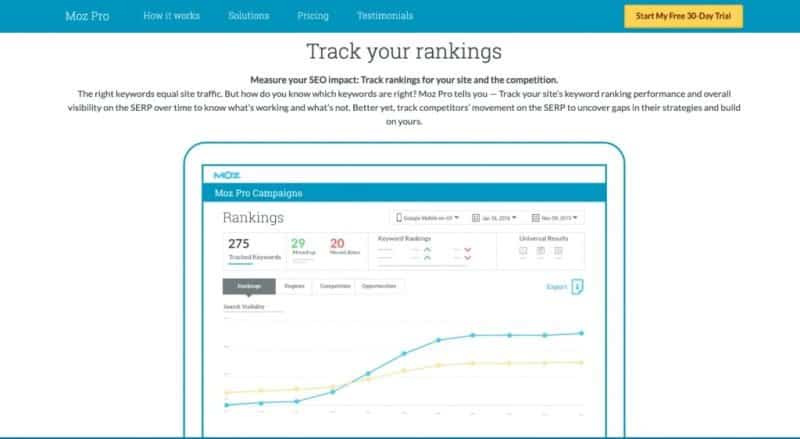
Google penalties are the bane of every website, especially when they start to influence domain authority (and by extension, net traffic). Learning to abide by the guidelines set by the search engine can save you the hassle of having to fix up bad links or practices that are causing your domain authority to sink.
The most common penalty is the Algorithmic Penalty, which comes about due to a change in Google’s search algorithm. Simply stay updated and make adjustments according to the major updates and you should be fine.
Another common penalty is the Manual Review Penalty, which is a triggered algorithmic penalty, that is often related to Black Hat SEO practices or webspam.
Rectification of these missteps will not take place immediately, only gradually, so be prepared not to see instant results even after clearing spam links and cleaning up the site. Most site penalties are related to poor backlink quality, spam and links from unscrupulous sites. Do not hesitate to disavow links that are harming your website, as that can make a difference in the long term.
The problem is that most of us don’t even know we’ve been penalised until it’s too late.
How then do you monitor your website’s status?
Google Analytics offers insights into your traffic, ranking status, and provides tools that diagnose your website’s health.
Moz Rank Tracker is an option as well, but it isn’t free to use, but seeing that they are the creators of domain authority, there is a wealth of options to be had by subscribing to their Rank Tracker. This includes keywords, domain visibility and competitor analysis.
Getting back to penalties, once you have used the relevant software to identify weak points which may lead to penalties, rectify them immediately, and be sure to learn from that mistake.
6. Remove Spam
This should be reiterated again and again – spam is unpleasant for both yourself and the user, so make sure your site is clean and polished.
Disavow toxic links and remove things that clutter the website, whether it was leftover trash from the domain’s previous owner or simply unwanted baggage.
The Nooks & Crannies of Domain Authority

Here are some tips that may overlap or do not fall into the previous categories. They are just as important to ensuring a great foundation for increased domain authority.
1. Adopting a White Hat SEO Philosophy
If you started to notice a pattern, it would be that the dos and don’ts of this article mainly correspond to the duality of White Hat and Black Hat SEO.
For the beginners among us, Black Hat SEO is a type of shady, underhanded philosophy that is characterised by prioritising short term gains over long term ones, and may not add value to the user (i.e stuffing keywords, buying backlinks from loan sites, etc.) while White Hat SEO is the right way to do things (essentially).
White Hat SEO practitioners value integrity and the user experience, which translates into natural gains in traffic.
An apt analogy is the comparison between an athlete that uses steroids for quick gains versus one that trains hard and eats right over a longer period of time. The former will crash and burn eventually, while the latter will reap rewards that last.
Examples that fall under White Hat SEO include making connections with other bloggers, creating high quality content that is magnetic, guest blogging and interacting with users via social media to create valuable content. In essence, contributing to the information ecosystem in a useful way is considered White Hat SEO.
In the end, adopting a natural, organic method of gaining traffic is ideal as it allows one to avoid penalties and a drop in domain authority. It is also the path that leads to better retention of users in the long run.
2. Analyse Your Competition
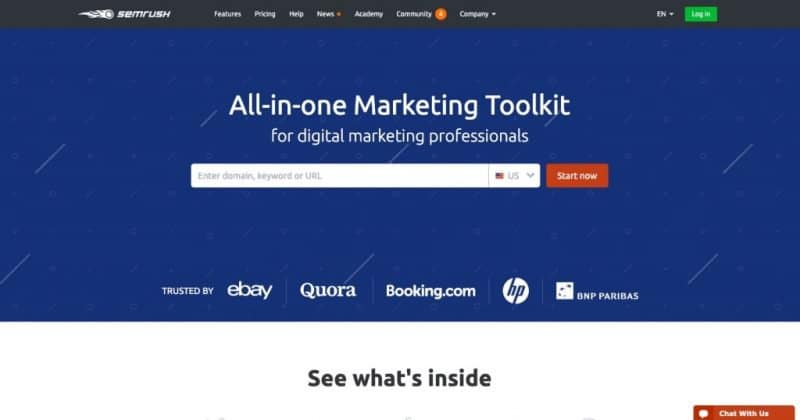
You can’t play the game of domain authority if you do not acknowledge your rivals. In the fast-paced world of technology, you may want to overtake your competition, but first, you need to know where they are on the map.
With tools such as SEMrush, Buzzsumo and more, you can research the others in your field and look to them for inspiration, as well as look to take over their spot as top dog in the business.
SEMRush’s handy tool allows one to do a side by side comparison of domains, which is pretty useful for analysis.
In terms of content, you can analyse competitors’ blogs, newsletters and media to see what they’re doing wrong – or what they are doing right, and make the necessary adjustments to your own content.
You can also sniff out their marketing strategy and evaluate how yours matches up to theirs.
3. Domain Age
Sometimes, it just takes time.
Domain age is one of the various factors affecting domain authority, and if your website is relatively new, it may suffer in this regard. Simply giving your website time to develop (years) may be helpful as you accumulate high-quality content, backlinks and connections over the years.
Being patient and not expecting immediate results can pay dividends, especially if your site is just beginning to pick up steam.
In Conclusion…

Domain authority cannot be influenced directly per se, only affected via the various metrics and components such as social media presence, technical SEO, backlink quality, content quality and domain age.
It is crucial to target overall SEO development to improve the user experience and provide useful information in whichever field one is specializing in, as a net increase in SEO quality generally correlates to a net increase in domain authority.
Explore More Content
Table of Content

